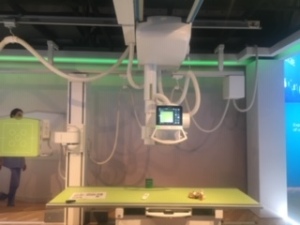Philips unveils new ceiling-mounted digital radiography system at RSNA
por
John R. Fischer, Senior Reporter | November 29, 2018

Philips Digital Diagnost C90
Royal Philips debuted its premium ceiling-mounted digital radiography system this week at the 2018 Radiological Society of North America conference in Chicago.
Dubbed Philips Digital Diagnost C90, the solution is designed to support patient throughput, incorporating a variety of tools that reduce the need for retakes of procedures, saving time and creating a faster workflow.
“What we’re really trying to do is take seconds off the process a little bit at a time. We think we’re saving 28 seconds off each exam,” Dave Nelson, director of field marketing and sales support for diagnostic imaging, DXR at Philips, told HCB News. “Between it and our Skyflow system, which saves up to 30 seconds per exam, we’re trying to save our customers an hour a day, which is huge. That’s our aim for this system.”
Retakes are mainly caused by patient movement, which is responsible for two-thirds of such instances.
With Philips Digital Diagnost C90, technologists can avoid this using the Eleva Tube Head touch screen display, which enables them to set correct positioning for the patient in the exam room before heading to the control area, where they can keep track of the camera on their monitor.
“You can tell if the patient has remained in the right position. If they’ve moved, you don’t have to take a bad shot. Just go back and correct the position, then come back again and take a good shot,” said Nelson.
It also allows users to set parameters such as correct fitness and technique in the exam room, offering them more time to spend with patients, and is used across a range of Philips digital radiography systems, sparing technologists the task of learning how to utilize it in different ways.
Additional components include two fixed detectors and a wireless one, as well as version two of Philips’ UNIQUE X-ray image processing software, which provides higher quality contrast and allows for customization to match user needs.
Though targeted at mainly large facilities, the solution can be used by smaller ones and once released, will be available for some time alongside the most recent incarnation of the Philips Digital Diagnost family, with users able to build and customize as they see fit.
“We can do a system where you simply share one wireless detector. You can put it in the table bucky for one exam and move it to the wall bucky for another exam, and use it for free imaging,” said Nelson. “That really reduces your cost because you only have one wireless detector. Or you can build it up to a full system like this where you have two fixed detectors and a wireless, giving you three detectors.”
The solution is CE marked and is currently FDA 510(k) pending with an expected release date slated for sometime in 2019.
|
|
|
You Must Be Logged In To Post A Comment
|
